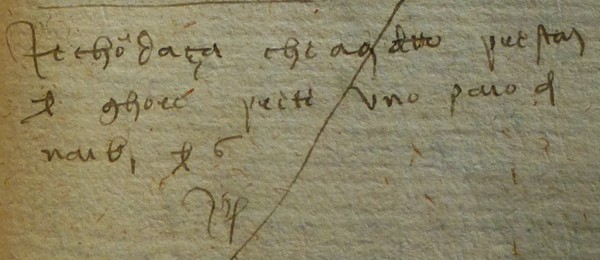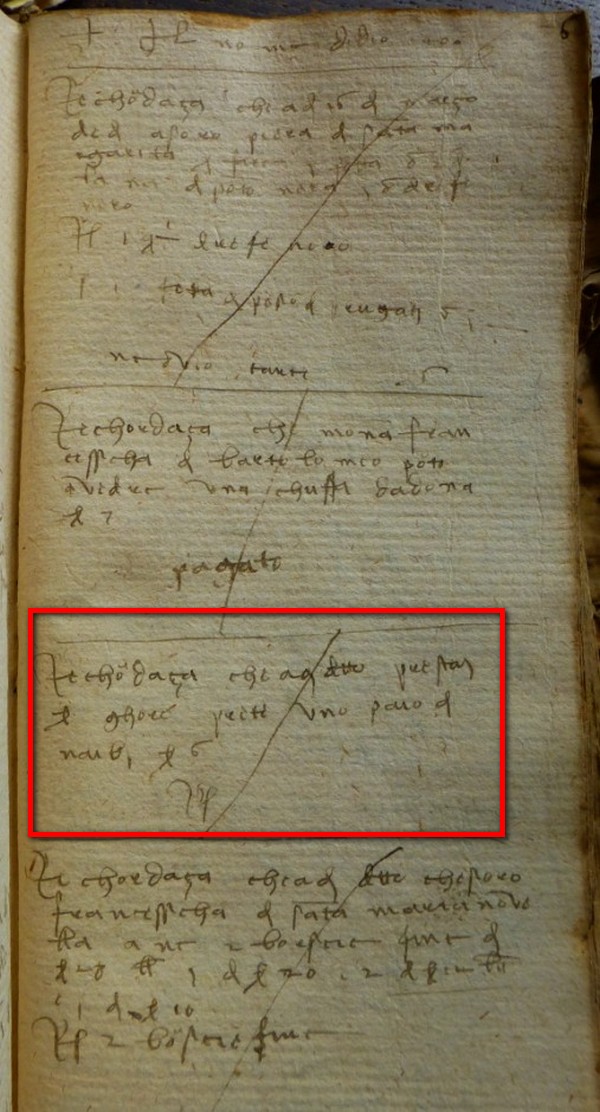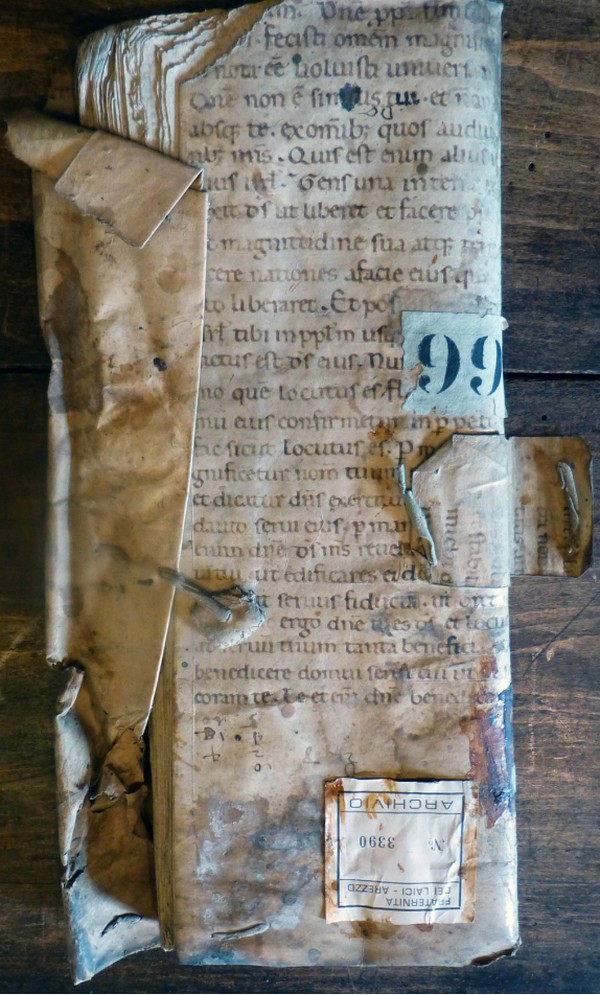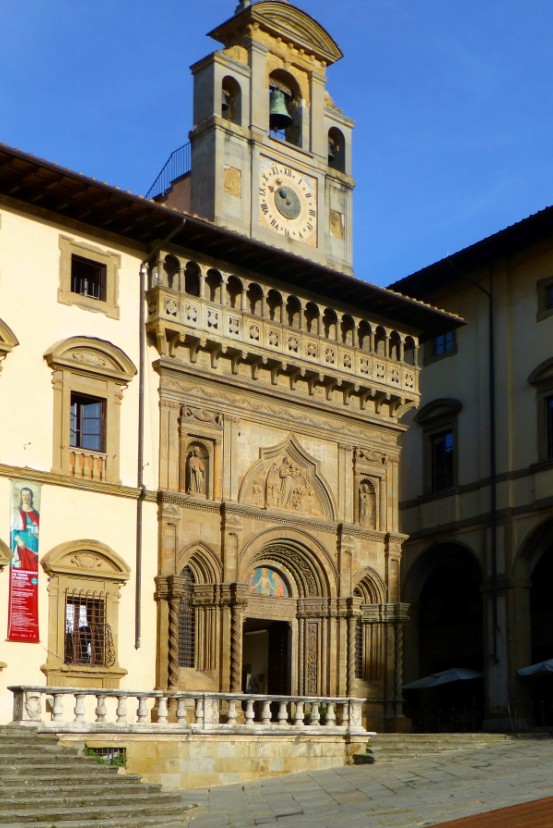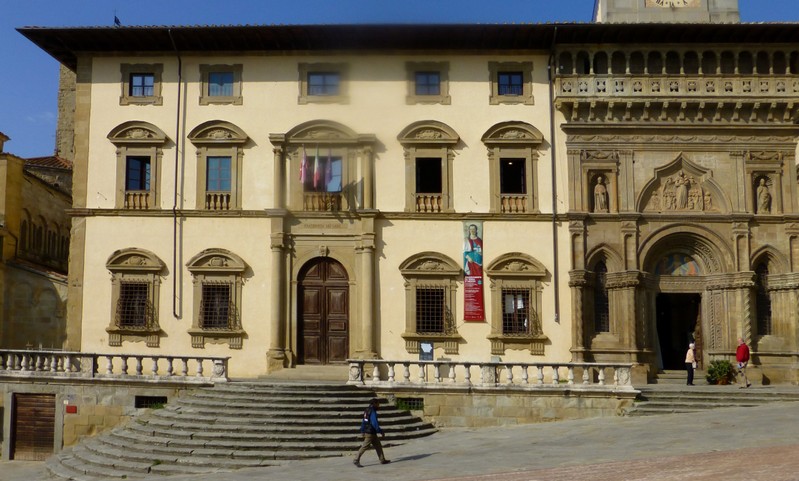Introduction
In my previous notes,(1) I had the opportunity to describe findings from several archives, mainly in Florence, but also in nearby towns, such as Siena and Prato. Now the same research has been extended to Arezzo and the first relevant document that I found there is discussed in this note.
Arezzo is a town with a very ancient and important tradition in Tuscany. As far as I understand it, all Tuscan main towns, with a few exceptions, have something to reproach to Florence, the chief town that hampered their progress instead of assisting it. Probably, Arezzo has been the least assisted of them all – practically, all the credit for what the citizens have obtained there must be given to themselves. We are dealing below with one of their ancient institutions, which they have been able to keep active up to nowadays.
Fraternita dei Laici
The Fraternita dei Laici is a fundamental institution in Arezzo.(2) It is not common that a company of this kind could be operating so long, in this case with charitable activities still under way.
The name itself of Fraternita dei Laici, or Lay Fraternity, sounds unusual: currently any fraternity or brotherhood implies a company of friars or religious persons: Laico on the contrary indicates precisely someone who is not a believer, or, at least, who does not act as such. Judging from its present name, one might suppose that this was not one of the many religious companies that existed at the time, but that it was instead led by a secular head and staff, with no clerical involvement. This is not true: it really was the Compagnia di Santa Maria della Misericordia; it had been originally established by the Dominicans, already in 1262. In the course of time it changed its name, but not much else.
The reason why this particular Company succeeded in continuing its activity has however some connection with its name. Actually, all the many religious Companies were suppressed in the 1780s by Grand Duke Pietro Leopoldo. If I have understood well, they assumed the denomination of Fraternita dei Laici, just for confirming that their activity was not the usual one of regularly meeting for praying together, but was instead addressed to assist the townspeople in case of illness, death, indigence, in addition to promoting education and culture. Clearly, when religious companies are being suppressed, companies of laymen are not involved.
Palazzo della Fraternita dei Laici
The Palace is interesting from several points of view.(3) We can begin with its location directly in the Piazza Grande, on one side contiguous with the ancient church of Santa Maria della Pieve, on the other adjacent to the great Palazzo delle Logge, designed by Giorgio Vasari. In front, we see several old palaces and the view of embattled towers, one directly on the place, another nearby.
Piazza Grande may be compared with analogous places of Tuscan towns: not as famous as Pisa’s Miracoli, or Siena’s Campo, or Florence’s Signoria, it is nevertheless the typical main place of the town from the Middle Ages. Still nowadays, traditional fairs and exhibitions, such as the Giostra del Saracino, are enjoyed there by the local population, and by many tourists as well.
The façade of the Palace contains parts built in different centuries (from the 14th to the 16th) and in different styles, but they have been wisely mixed together in a fine balance of Gothic and Renaissance features. Particularly appreciated by the experts are the portal and the lunette above it (see photos), the latter a fine work by Bernardo Rossellino (1409-1464), who also designed part of the façade.
In the upper part, a bell tower has been designed by Giorgio Vasari; there we find another renowned object, the clock made in 1552 by Felice da Fossato. It has several interesting mechanisms and features, with the Earth placed in the centre of the clock-face and the Moon and the Sun rotating around it. Let me refer for more detail to a description in the web,(4) quoting here only its conclusion: “It should be pointed out that it is quite rare to find clocks of this type still existent today.”
The interior is abundant of art objects and parts of architectonic interest. The Palace has the status of a real museum, with recurrent group visits by tourists coming from everywhere.
The Archivio Storico
What we find now in the Palace is only a small part of the many documents and objects of historical and artistic interest accumulated for eight centuries by the Fraternita: the original patrimony has been used in the course of time for increasing the collections of several other museums and libraries of Arezzo, practically all of them, or at least the most important ones.
If one is disappointed for this dispersion of so many art objects, it may be useful to reflect on what they have avoided: in principle, most of these documents and objects could have arrived into Florence during the 1780s. (Their success has for me personally the drawback that I cannot study the documents at ease in the ASF, as occurs for similar ones.)
Our interest is limited to their historical archive, ASFdL, and only to a part of it. We are already accustomed to the situation, which we can easily remember on the basis of the AOIF.(1) Here too we have many books of the general administration of the Fraternita, which are practically of no interest to us.
What is interesting is its section of Testatori, as is called here. This name is not common in the archives, where Eredità (inheritances) is usually preferred, but testators are exactly those who left their possessions to the Fraternita, and their account books with them. A section of this kind exists in most archives of hospitals, religious companies, monasteries. Usually, a section of Eredità is present as a small one in these archives. The majority of the corresponding books actually contain either domestic or agrarian trades, or both of them together. Another drawback for us is that most of these books, in any archive, belong to the 17th or later centuries.
A two-volumes Inventory(5) of 540 pages has been published on the items kept in the ASFdL. Of our specific interest are books listed there from number 3294 to 3618, forming the last part of the Inventory, precisely that of Testatori. This section is not as rich as the corresponding one of Estranei in the AOIF, but it nevertheless contains no less than 325 books. What greatly increases the interest of this set of documents is that we find here some books of the 14th century, and a remarkable number of the 15th century, of our specific interest.
As a whole, this section is more useful than average, and its early part can be considered one of the largest sections of this kind in all the Tuscan archives; we may as well extend the scale to Italy, or even to the whole of Europe.
Giglio di Bettino, Setaiolo e Merciaio
The book under investigation here is one among the few account books that I had selected for a first survey. (As yet, I found nothing of interest in the other ones.) There was some reasons for choosing this book. In particular, there was something promising in the double profession indicated by the trader, Giglio di Bettino: Setaiolo e Merciaio, silk dealer and mercer. This obviously reminded me of similar shops recently visited in the AOIF with many records of playing cards.(1)
For the moment, I have not found much information about this trader. In 1425, he appears as a fidejussor, mentioned as a silk-dealer from Arezzo in the registers of the Opera del Duomo in Florence.(6)
He is moreover present in a book dealing with Arezzo’s economy at the time;(7) the reason why he is cited there is precisely his profession, as indicated by him in his account books: silk-dealer and mercer. This is assumed by Bruno Dini as a confirmation of the fact that at the time there were no silk producers in Arezzo, but just silk-dealers. In the Florentine terminology, all of them were “setaioli piccoli”, without any “setaiolo grande” existing locally.
We find him also in a book dedicated to the documents on the local schools and cultural life. He is cited there in a notary deed of 19 April 1436, copied from the original document kept in the ASF, where he appears as a witness when the will of Maestro Francesco di Ser Feo di Nigi was registered.(8)
These documents clearly correspond to a later stage of his life - apparently, he still was a relatively young mercer in 1400, the year of the document discussed here.
Just one record - my first finding in Arezzo
The book under discussion(9) is indicated in the Inventory as “vacchetta”: this name corresponds to a book with about half the usual width, cm 11x30 in this case. I had selected it among other possible books of the same trader for more than one reason. The title itself “Quadernuccio di ricordanze” appeared promising to me: Ricordanze I had already found in the AOIF as the most suitable kind among account books, and Quadernuccio, small cash-book, is exactly the kind of book, in which minute trades are more probably recorded.
The dates of the records in this cash-book are very early for our subject, 1400-1406. Now, those years appear to be too early for searching any Trionfi, even to me. Thus, what we are searching here are just Naibi, and one pack of Naibi is what I actually have found there. On fol. 6a I read:
| «Richordança che a dì detto prestai a ghoro prete uno paio di naibi s.6.». |
The handwriting is clear enough. The “dì detto”, the day mentioned above, was the 16 March 1400 - which remains as such, because they did not use the Florentine system for the dates. The following is: “I lent to priest Goro a pack of Naibi, s.6”.
There is a certain probability that instead of Goro “prete”, priest, we have to read Preti, family name. This might somewhat decrease the interest of the document, but I am sure that it is not owing to the possible increase of interest that I prefer the “prete” reading.
Discussion
What is difficult to distrust in the entry above is the verb “prestai”, I lent. Its reading is certain - for me at least. Now, I am not able to imagine that at the time this word had a different meaning in Arezzo: they could use local idioms, OK; more than six century have passed since then, OK; yet, nobody will convince me that their “prestai” at the time was different from my “prestai” of nowadays!
Such being the case, we learn that at the very beginning of the 15th century a pack of Naibi could be lent in Arezzo at the price of s.6. This is all, for the moment. The obvious subsequent question is: if s.6 were needed for a loan, what was needed for purchasing a new pack? I do not know a precise relation between the two trades, which could even not exist at all. If we assume that the upper limit was at about half price, this pack of Naibi could cost at least s.12, but probably more, thus seemingly more expensive than average (in so far as we can compare these prices with those known for later years).
It remains to figure out if this loan was due to the difficulty of finding new Naibi packs on sale in Arezzo, where a local abundant production at the time is hard to imagine, or just because this kind of trade was found as a more comfortable way. I prefer the second guess.
If you borrow something, you do it for a particular necessity, you use the object for your aims and you give it back as soon as possible. In particular, in the specific case of a card pack, it is not possible to use it for a long time, and return it fully worn out.
Of course, discovering that it really was a priest to borrow the pack from the silk-dealer is something of historical relevance - he had only the fortune that Saint Bernardino of Siena had by then caught the bubonic plague, and only five years later on obtained his authorisation as a preacher.
We remain however curious to visualise where and with whom our priest Goro played, and at which game; which was the special event for employing these playing cards that he had borrowed for a price probably higher than required for acquiring a new “dozzinale” pack.
If one searches in some old calendar at home, one finds that in 1400 the Easter date was the 18 April, and connoisseurs thus know that the 16 March was a day during Lent, not exactly the best time, for a priest, to play cards, or any other game.
Conclusion
In my research of documents useful for the initial history of playing cards I have entered a new archive, ASFdL, of Fraternita dei Laici in Arezzo. They have a Testatori section, with many account books of the time of interest, and even earlier.
From the first account books that I have examined, just one entry in a cash-book of a retailer is reported and discussed here. It is a small piece of evidence but it provides a really new information at such an early date. The record is for s.6 received in March 1400 for having lent a pack of Naibi to Goro, probably a priest.
What is most interesting and new in this information is not the pack of Naibi, already mentioned for more than twenty years, nor the cost of s.6, which could be expected from later information on expensive packs (even if the exact prices at the time are unknown to me); most interesting is the unexpected news that Naibi packs were by then also lent for a price, in addition to currently being sold and purchased.
Footnotes:
(1) Franco Pratesi: Articles to playuin card research, 2011/12
(2) Fraternica dei Laici ; Ersilia Agnolucci, La città della Fraternita, Fraternita dei Laici, Arezzo 1992.
(3) Maria Mercantini, Il Palazzo di Fraternita in piazza Grande ad Arezzo. Arezzo 1980.
(4) Palazzo della Fraternita dei Laici
(5) Augusto Antoniella, L'archivio della Fraternita dei laici di Arezzo. I, Scandicci 1985; II, Milano 1989
(6) www.operaduomo.firenze.it DOCUMENTO: o0201086.073vc
(7) Bruno Dini, Arezzo intorno al 1400 : produzioni e mercato. Arezzo 1984.
(8) Robert Black [Ed.], Studio e scuola in Arezzo durante il Medioevo e il Rinascimento. Arezzo 1996.
(9) ASFdL 3390.
|
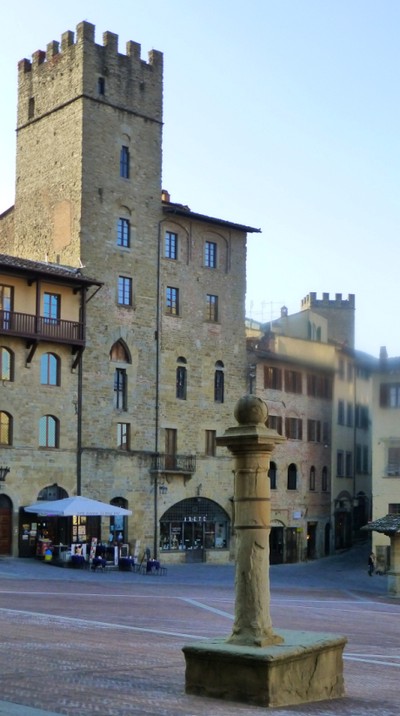
Arezzo, market-place
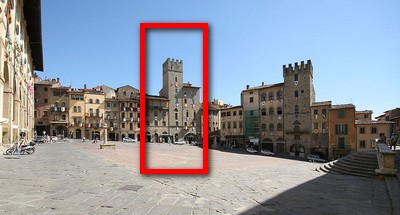
Arezzo - Anghiari, about 30 km
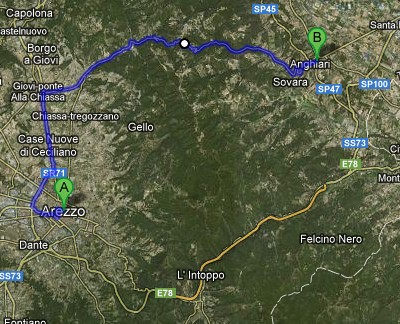
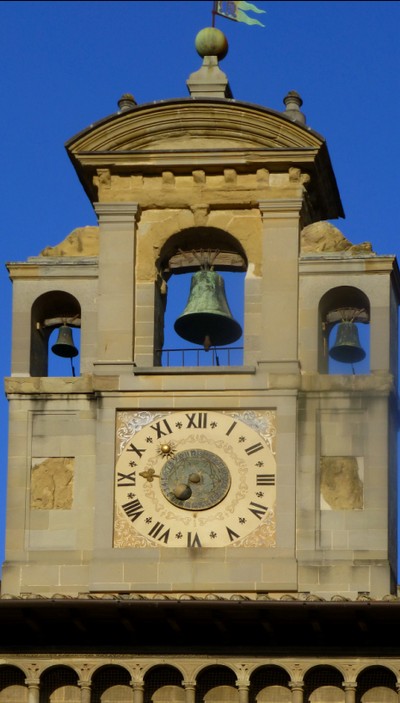
|
|
